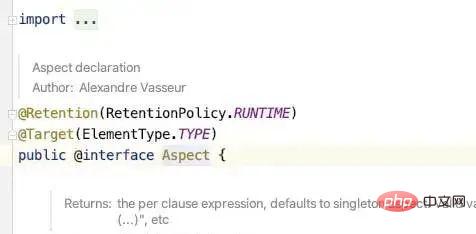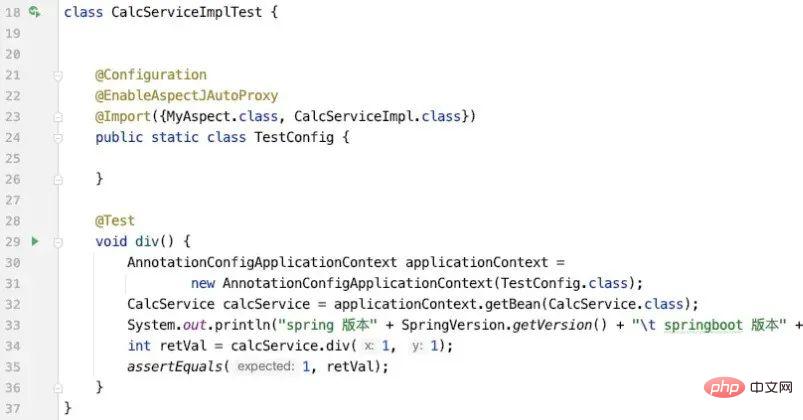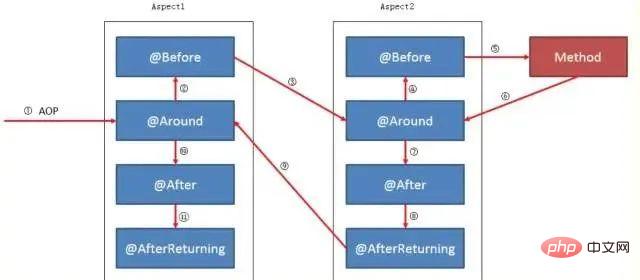Interviewer: Spring Aop common annotations and execution sequence
Recently, when I was revising resumes and doing mock interviews for many people, some friends gave me feedback on Spring AOP interview questions, and I will ask them today.
The most powerful thing about Spring at the beginning is the two core functions of IOC/AOP. Today we will learn about the common annotations and execution sequence of Spring AOP.
Spring interview core points:
IOC, AOP, Bean injection, Bean life cycle, Bean circular dependency
First of all we Let’s review some commonly used annotations in Spring Aop:
@BeforePre-notification: Execute before the target method-
@AfterPost notification: executed after the target method (always executed) @AfterReturningPost notification: execution method ends Execute before (not executed if exception occurs)@AfterThrowingException notification: Execute after exception@AroundAround notification: Around target method execution
##FAQ
1. You must know Spring. Let’s talk about the order of all notifications of Aop. How does Spring Boot or Spring Boot 2 affect the execution order of aop? 2. Tell us about the pitfalls you encountered in AOP?Sample code
Let’s quickly build a demo program of spring aop to discuss spring together Some details in aop.
Configuration file
For the convenience, I directly use spring-boot for quick projects To build, you can use the spring-boot project quick creation function of idea, or go to start.spring.io to quickly create a spring-boot application.
Because I often manually post some dependencies on the Internet, there are some problems such as dependency conflicts and service startup failure.
plugins {
id 'org.springframework.boot' version '2.6.3'
id 'io.spring.dependency-management' version '1.0.11.RELEASE'
id 'java'
}
group 'io.zhengsh'
version '1.0-SNAPSHOT'
repositories {
mavenCentral()
maven { url 'https://repo.spring.io/milestone' }
maven { url 'https://repo.spring.io/snapshot' }
}
dependencies {
# 其实这里也可以不增加 web 配置,为了试验简单,大家请忽略
implementation 'org.springframework.boot:spring-boot-starter-web'
implementation 'org.springframework.boot:spring-boot-starter-actuator'
implementation 'org.springframework.boot:spring-boot-starter-aop'
testImplementation 'org.springframework.boot:spring-boot-starter-test'
}
tasks.named('test') {
useJUnitPlatform()
}Interface class
First we need to define an interface. Here we can review the choice of JDK's default proxy implementation:
If the target object implements the interface, the JDK dynamic proxy is used by default If the target object does not implement the interface, use dynamic proxy If the target object implements the interface and Cglib is forced, use cglib proxy
The logic of this piece is in DefaultAopProxyFactory If you are interested, you can take a look.
public interface CalcService {
public int div(int x, int y);
}Implementation class
Here we will simply do a division operation, which can simulate normal or easy errors.
@Service
public class CalcServiceImpl implements CalcService {
@Override
public int div(int x, int y) {
int result = x / y;
System.out.println("====> CalcServiceImpl 被调用了,我们的计算结果是:" + result);
return result;
}
}aop interceptor
#To declare an interceptor, we need to add @Aspect and @Component to the current object. The author has only stepped on it before. Only one such pit has been added.
其实这块我刚开始也不是很理解,但是我看了 Aspect 注解的定义我就清楚了

这里面根本就没有 Bean 的定义。所以我们还是乖乖的加上两个注解。
还有就是如果当测试的时候需要开启Aop 的支持为配置类上增加@EnableAspectJAutoProxy 注解。
其实 Aop 使用就三个步骤:
定义 Aspect 定义切面 定义 Pointcut 就是定义我们切入点 定义具体的通知,比如: @After, @Before 等。
@Aspect
@Component
public class MyAspect {
@Pointcut("execution(* io.zhengsh.spring.service.impl..*.*(..))")
public void divPointCut() {
}
@Before("divPointCut()")
public void beforeNotify() {
System.out.println("----===>> @Before 我是前置通知");
}
@After("divPointCut")
public void afterNotify() {
System.out.println("----===>> @After 我是后置通知");
}
@AfterReturning("divPointCut")
public void afterReturningNotify() {
System.out.println("----===>> @AfterReturning 我是前置通知");
}
@AfterThrowing("divPointCut")
public void afterThrowingNotify() {
System.out.println("----===>> @AfterThrowing 我是异常通知");
}
@Around("divPointCut")
public Object around(ProceedingJoinPoint proceedingJoinPoint) throws Throwable {
Object retVal;
System.out.println("----===>> @Around 环绕通知之前 AAA");
retVal = proceedingJoinPoint.proceed();
System.out.println("----===>> @Around 环绕通知之后 BBB");
return retVal;
}
}测试类
其实我这个测试类,虽然用了 @Test 注解,但是我这个类更加像一个 main 方法把:如下所示:

执行结论
结果记录:spring 4.x, spring-boot 1.5.9
无法现在依赖,所以无法试验
我直接说一下结论:Spring 4 中环绕通知是在最里面执行的
结果记录:spring 版本5.3.15 springboot 版本2.6.3

多切面的情况
多个切面的情况下,可以通过@Order指定先后顺序,数字越小,优先级越高。如下图所示:

代理失效场景
下面一种场景会导致 aop 代理失效,因为我们在执行 a 方法的时候其实本质是执行 AServer#a 的方法拦截器(MethodInterceptor)链, 当我们在 a 方法内直接执行b(), 其实本质就相当于 this.b() , 这个时候由执行 a方法是调用到 a 的原始对象相当于是 this 调用,那么会导致 b() 方法的代理失效。这个问题也是我们开发者在开发过程中最常遇到的一个问题。
@Service
public class AService {
public void a() {
System.out.println("...... a");
b();
}
public void b() {
System.out.println("...... b");
}
}The above is the detailed content of Interviewer: Spring Aop common annotations and execution sequence. For more information, please follow other related articles on the PHP Chinese website!

Hot AI Tools

Undresser.AI Undress
AI-powered app for creating realistic nude photos

AI Clothes Remover
Online AI tool for removing clothes from photos.

Undress AI Tool
Undress images for free

Clothoff.io
AI clothes remover

AI Hentai Generator
Generate AI Hentai for free.

Hot Article

Hot Tools

Notepad++7.3.1
Easy-to-use and free code editor

SublimeText3 Chinese version
Chinese version, very easy to use

Zend Studio 13.0.1
Powerful PHP integrated development environment

Dreamweaver CS6
Visual web development tools

SublimeText3 Mac version
God-level code editing software (SublimeText3)

Hot Topics
 1359
1359
 52
52
 Square Root in Java
Aug 30, 2024 pm 04:26 PM
Square Root in Java
Aug 30, 2024 pm 04:26 PM
Guide to Square Root in Java. Here we discuss how Square Root works in Java with example and its code implementation respectively.
 Perfect Number in Java
Aug 30, 2024 pm 04:28 PM
Perfect Number in Java
Aug 30, 2024 pm 04:28 PM
Guide to Perfect Number in Java. Here we discuss the Definition, How to check Perfect number in Java?, examples with code implementation.
 Random Number Generator in Java
Aug 30, 2024 pm 04:27 PM
Random Number Generator in Java
Aug 30, 2024 pm 04:27 PM
Guide to Random Number Generator in Java. Here we discuss Functions in Java with examples and two different Generators with ther examples.
 Armstrong Number in Java
Aug 30, 2024 pm 04:26 PM
Armstrong Number in Java
Aug 30, 2024 pm 04:26 PM
Guide to the Armstrong Number in Java. Here we discuss an introduction to Armstrong's number in java along with some of the code.
 Weka in Java
Aug 30, 2024 pm 04:28 PM
Weka in Java
Aug 30, 2024 pm 04:28 PM
Guide to Weka in Java. Here we discuss the Introduction, how to use weka java, the type of platform, and advantages with examples.
 Smith Number in Java
Aug 30, 2024 pm 04:28 PM
Smith Number in Java
Aug 30, 2024 pm 04:28 PM
Guide to Smith Number in Java. Here we discuss the Definition, How to check smith number in Java? example with code implementation.
 Java Spring Interview Questions
Aug 30, 2024 pm 04:29 PM
Java Spring Interview Questions
Aug 30, 2024 pm 04:29 PM
In this article, we have kept the most asked Java Spring Interview Questions with their detailed answers. So that you can crack the interview.
 Break or return from Java 8 stream forEach?
Feb 07, 2025 pm 12:09 PM
Break or return from Java 8 stream forEach?
Feb 07, 2025 pm 12:09 PM
Java 8 introduces the Stream API, providing a powerful and expressive way to process data collections. However, a common question when using Stream is: How to break or return from a forEach operation? Traditional loops allow for early interruption or return, but Stream's forEach method does not directly support this method. This article will explain the reasons and explore alternative methods for implementing premature termination in Stream processing systems. Further reading: Java Stream API improvements Understand Stream forEach The forEach method is a terminal operation that performs one operation on each element in the Stream. Its design intention is




